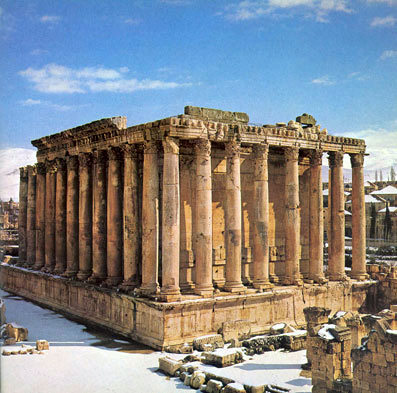The
Baalbek Platform - Temple of Bacchus

North
of Palestine the high fertile plain of the Bekaa valley spreads
out between the Lebanon and Anti-lebanon mountains. These parallel
ranges of mountains form the sides of the rift valley geological
structure, which runs all the way from southern Africa, as far
as Turkey, two hundred miles to the north.
From the Mediterranean, the land rises by degrees to the snow
clad mountains seen in the background of this picture. The highest
parts of the mountains reach 10,000 feet, and the slopes were
once covered with the mighty Lebanon cedar trees.
The name Baalbek translates as valley of the great lord,
an expression of great significance in the interpretation of
the past. The town stands on a key spring head site at the high
point of the watershed at a level of 3,450 feet. The river Orontes
flows north through Kadesh and Homs to the plain of Antioch,
and the Litani flows southwards and then westwards to join the
Mediterranen near Tyre.
It was from Tyre, Sidon and in particular Byblos on the coast,
reputed to be amongst the world's oldest cities and ports, that
cedar timber was shipped to Egypt before 3,000 BC. This was
the area praised by the prophets of the Old Testament for its
beauty in their poetic imagery. This was the area of the sacred
cedar forest and the sacred cedar groves.
To the Romans this large valley and plain was known as their
granary. The suitability for agriculture and the numerous mounds,
remains and relics in the area, bear witness that the valley
must have been heavily populated in the most ancient times.
In the Sumerian texts we find that it was decreed that Baal
Hadad should govern the highlands in which Ba'albek would later
stand. Constantine is reputed to have still regarded Baal Hadad
as the supreme being, when he adopted Christianity for the Roman
Empire.
Up to that time, c. AD 300, people had come for at least 2,000
years on pilgramage from Africa, Asia and Europe to pay their
respects to the Gods at the temples on the Baalbek platform,
of which the Temple of Bacchus shown here, is but a small chapel
incomparison to the main structures erected on the platform.
Alexander the Great conquered Baalbek c. 348 BC and re-named
it Heliopolis (City of theSun). The Temple of Baal Hadad at
both Baalbek and Damascus became known as the Temple of Jupiter
Heliopolitanus. Jupiter being the Roman name for Hadad.
Golden Age Project Comments
From Yahweh's Land - Photographs and Text by Alfons Senfter
 |
 |
|